Lawson: Cycle 3 “Wash Me Away and Birth Me Again”
Posted: December 14, 2023 Filed under: Nico Lawson, Uncategorized | Tags: Au23, Cycle 3, dance, Digital Performance, Isadora Leave a comment »Changes to the Physical Set Up
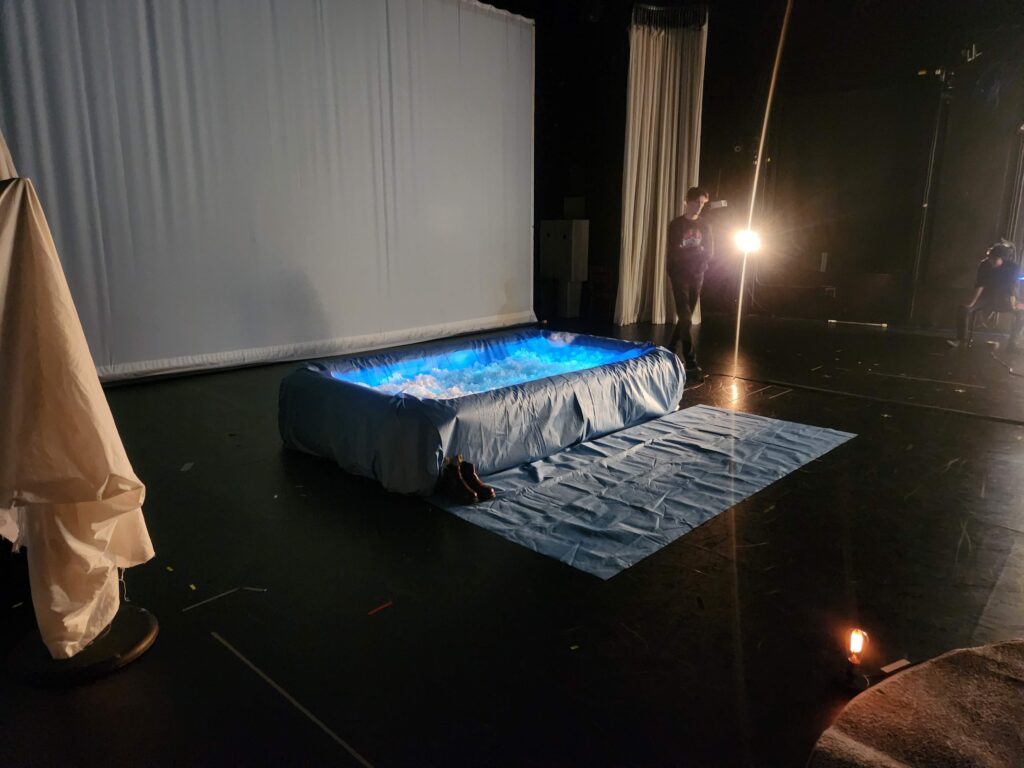
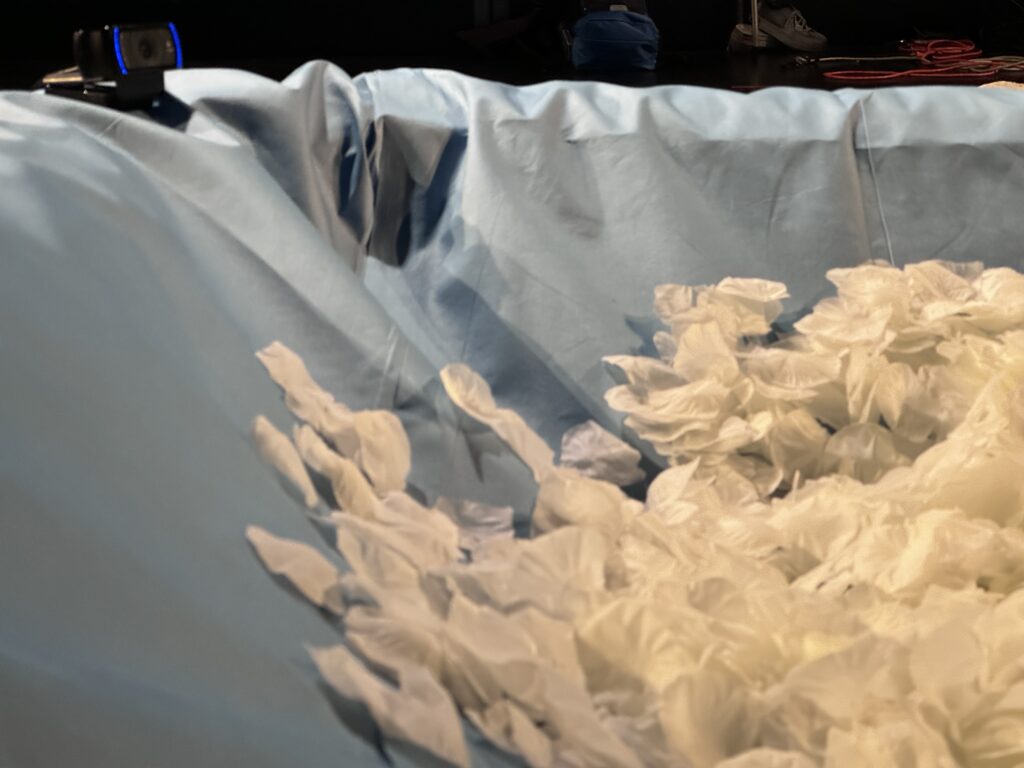
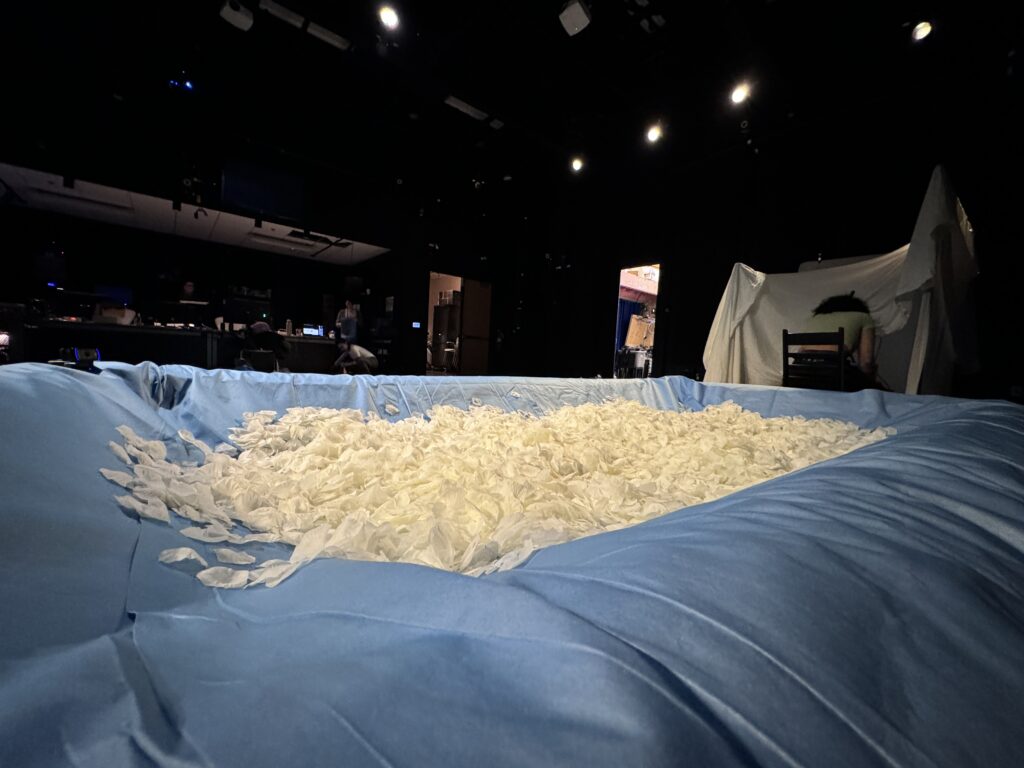
For cycle 3, knowing that I wanted to encourage people to physically engage with my installation, I replaced the bunched up canvas drop cloths with a 6 ft x 10 ft inflatable pool. I built up the bottom of pool with two folded wrestling mats. Building up the bottom of the pool made the pool more stable and reduced the volume of silk rose petals that I would need to fill the pool. Additionally, I wrapped the pool with a layer of blue drop cloths. This reduced the kitschy or flimsy look of the pool, increased the contrast of the rose petals, and allowed the blue of the projection to “feather” at the edges to make the water projection appear more realistic. To further encourage the audience to physically engage with the pool, I placed an extra strip of drop cloth on one side of the pool and set my own shoes on the mat as a visual indicator of how people should engage: take your shoes off and get in. This also served as a location to brush the rose petals off of your clothes if they stuck to you.
In addition to the pool, I also made slight adjustments to the lighting of the installation. I tilted and shutter cut three mid, incandescent lights. One light bounced off of the petals. Because the petals were asymmetrically mounded, this light gave the petals a wave like appearance as the animation moved over top of them. The other two shins were shutter cut just above the pool to light the participant’s body from stage left and stage right.
Changes to the Isadora Patch
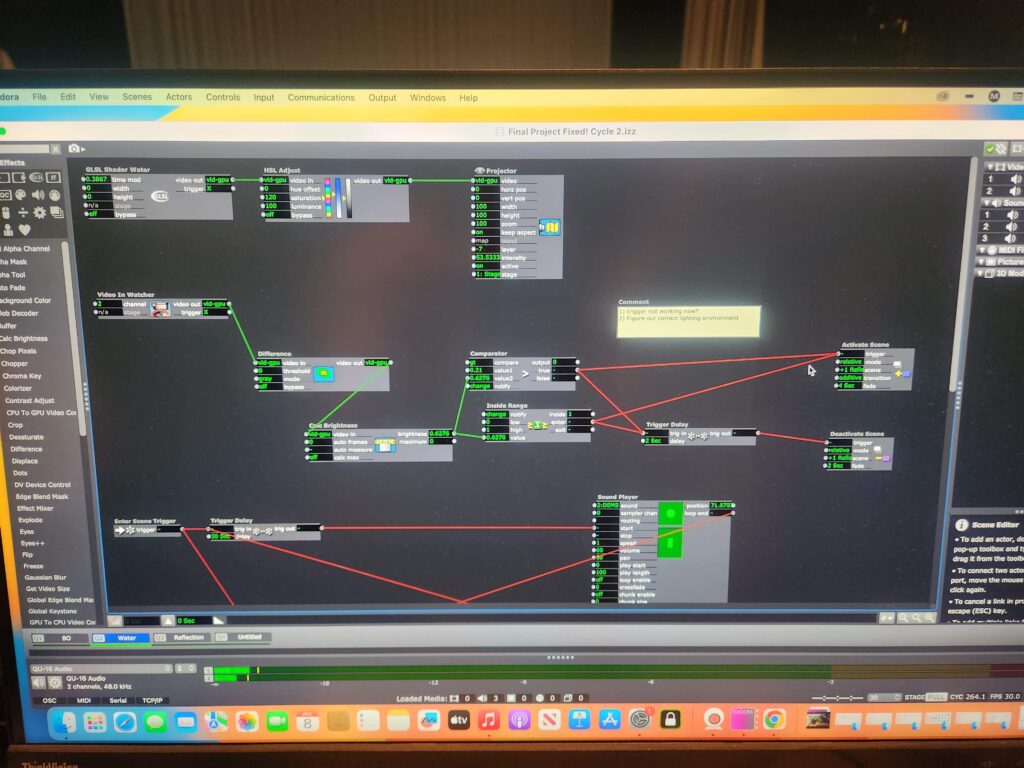
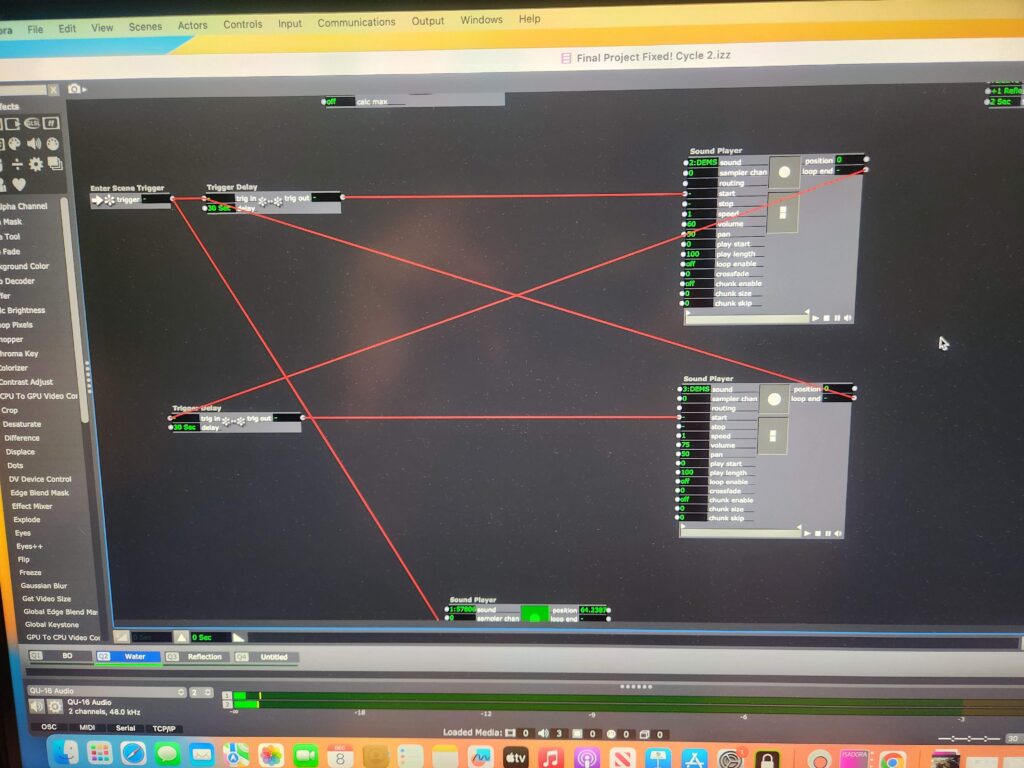

During cycle 2, it was suggested that I add auditory elements to my project to support participant engagement with the installation. For this cycle, I added 3 elements to my project: a recording of running water, a recording of the poem that I read live during cycle 2, and a recording of an invitation to the audience.
The words of the poem can be found in my cycle 2 post.
The invitation:
“Welcome in. Take a rest. What can you release? What can the water carry away?”
I set the water recording to play upon opening the patch and to continue to run as long as the patch was open. I set the recordings of the poem and the invitation to alternate continuously with a 30 second pause between each loop.
Additionally, I made changes to the reflection scene of the patch. First, I re-designed the reflection. Rather than using the rotation feature of the projection to rotate the projected image from the webcam, I used the spinner actor and then zoomed in the projection map so it would fit into the pool. Rather than try to make the image hyper-realistic, I decided to amplify the distortion of the reflection by desaturating it and then using a colorizer actor to give the edges of the moving image a purple hue. I also made minor adjustments to the motion blur to play up the ghostliness of the emmanation.
Second, I sped up the trigger delay to 3 seconds and the deactivate scene trigger to 2 seconds. I made this change as a result of feedback from a peer that assisted me with my adjustments to the projection mapping. She stated that because the length of time of the fading up and down of reflection scene took so long to turn on and off and the reflection itself was so subtle that it was difficult to determine how her presence in the pool was triggering any change. I found the ghostliness of the final reflection to be incredibly satisfying.
Impact of Motion Lab Set Up
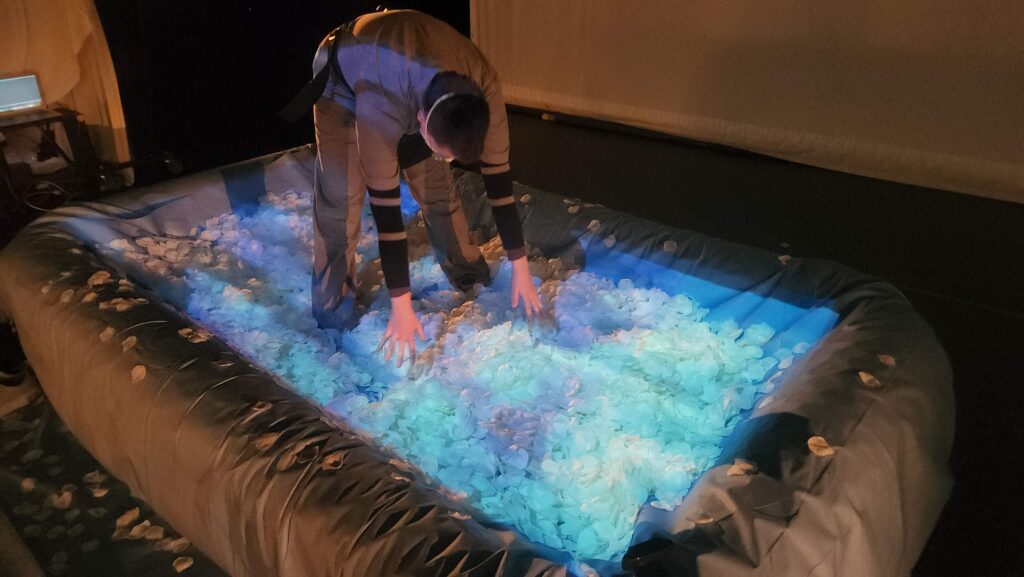
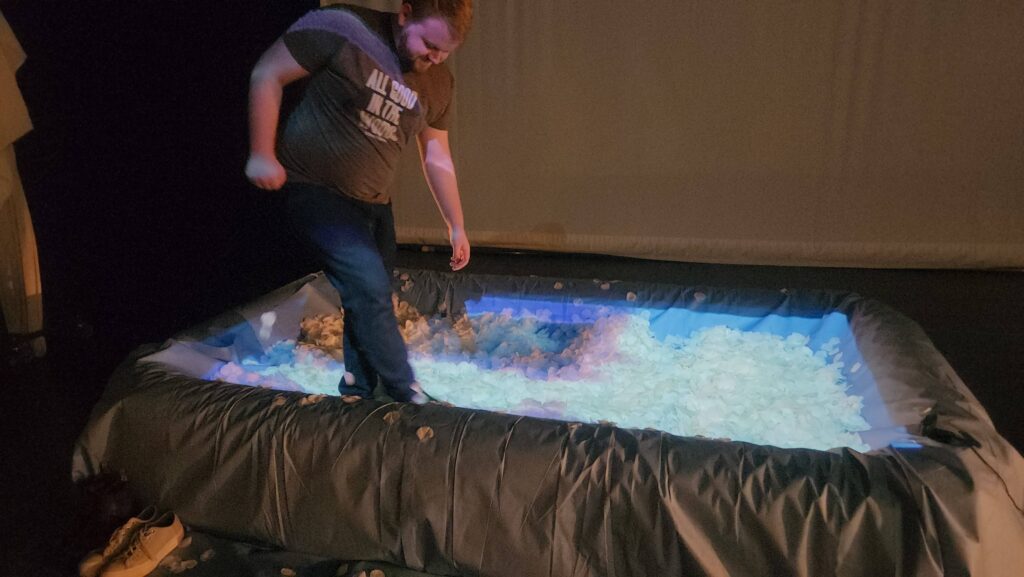
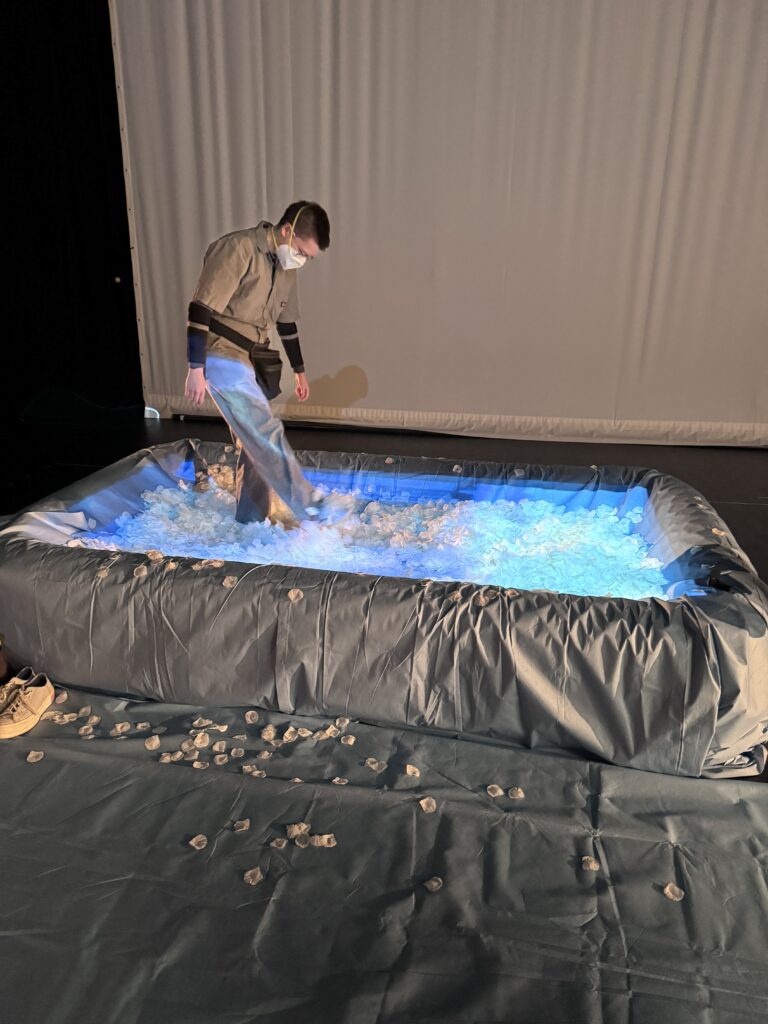
On the day of our class showing, I found that the presence of my installation in the context of other tactile and movement driven exhibits in the Motion Lab helped the handful of context-less visitors figure out how to engage with my space. When people entered the Motion Lab, they first encountered Natasha’s “Xylophone Hero” followed by Amy’s “seance” of voices and lightbulbs. I found that moving through these exhibits established an expectation that people could touch and manipulate my project and encouraged them engage to more fully with my project.
I also observed that the presence of the pool itself and the mat in front of it also encouraged full-body engagement with the project. I watched people “swim” and dance in the petals and describe a desire to lay down or to make snow angels in the petals. The presence of the petals in a physical object that visitors recognized appeared to frame and suggest the possibilities for interacting with the exhibit by making it clear that it was something that they could enter that would support their weight and movement. I also observed that hearing the water sounds in conjunction with my poem also suggested how the participants could interact with my work. Natasha observed that my descriptions of my movement in my poem help her to create her own dance in the pool sprinkling the rose petals and spinning around with them as she would in a pool.
The main hiccup that I observed was that viewers often would not stay very long in the pool once they realized that the petals were clinging to their clothes because of static electricity. This is something that I think I can overcome through the use of static guard or another measure to prevent static electricity from building up on the surface of the petals.
A note about sound…
My intention for this project is for it to serve as a space of quiet meditation through a pleasant sensory experience. However, as a person on the autism spectrum that is easily overwhelmed by a lot of light and noise, I found that I was overwhelmed by my auditory components in conjunction with the auditory components of the three other projects. For the purpose of a group showing, I wish that I had only added the water sound to my project and let viewers take in the sounds from Amy and CG’s works from my exhibit. I ended up severely overstimulated as the day went on and I wonder if this was the impact on other people with similar sensory disorders. This is something that I am taking into consideration as I think about my installation in January.
What would a cycle 4 look like?
I feel incredibly fortunate that this project will get a “cycle 4” as part of my MFA graduation project.
Two of my main considerations for the analog set up at Urban Arts Space are disguising and securing the web camera and creating lighting that will support the project using the gallery’s track system. My plan for hiding the web camera is to tape it to the side of the pool and then wrap it in the drop cloth. This will not make the camera completely invisible to the audience, but it will minimize it’s presence and make it less likely that the web cam could be knocked off or into the pool. As for the lighting, I intend make the back room dim and possibly use amber gels to create a warmer lighting environment to at least get the warmth of theatrical lighting. I may need to obtain floor lamps to get more side light without over brightening the space.
Arcvuken posed the question to me as to how I will communicate how to interact with the exhibit to visitors while I am not present in the gallery. For this, I am going to turn to my experience as neurodivergent person and my experience as an educator of neurodivergent students. I am going to explicitly state that visitors can touch and get into the pool and provide some suggested meditation practices that they can do while in the pool in placards on the walls. Commen sense isn’t common – sometimes it is better for everyone if you just say what you mean and want. I will be placing placards like this throughout the entire gallery for this reason to ensure that visitors – who are generally socialized not to touch anything in a gallery – that they are indeed permitted to physically interact with the space.
To address the overstimulation that I experienced in Motion Lab, I am also going to reduce the auditory components of my installation. I will definitely keep the water sound and play it through a sound shower, as I found that to be soothing. However, I think that I will provide a QR code link to recordings of the poems so that people can choose whether or not they want to listen and have more agency over their sensory experience.
Lawson: Cycle 2
Posted: November 30, 2023 Filed under: Nico Lawson | Tags: Cycle 2, dance, Digital Performance, Interactive Media, Isadora Leave a comment »The poem shared in the videos:
I’m sorry that I can’t be more clear.
I’m still waking up.
This body is still waking up.
What a strange sensation,
To feel a part of you dying while you’re still alive.
What a strange sensation for part of you to feel like someone else.
Maybe she was someone else.
I can’t explain the relief that I feel to let her go.
I can’t explain the peace that I feel,
To give myself back to the dust,
On my own terms this time.
That’s just it.
My past life, Wisteria’s life, is dust.
That life caught fire and returned to the durst from which it came…
But the rain came just as it always does
Cleansing tears and eternal life cycle.
It reminds me that this body is seventy percent water
Intimately tied to planer just the same
That will always come to claim it’s own.
Wash me away and birth me again.
When I still prayed to a god they taught me about baptism.
How the water washes away your sin.
How you die when they lay you down.
How you are reborn when they raise you up.
While Wisteria turns to dust,
I return myself to the water, still on my own terms.
I watch my life in the sunlight that dances on the surface
Let the current take her remains as my tears and the Earth’s flow by.
Grieving…
Lost time
Self-loathing
The beautiful possibilities choked off before they could take root
The parts of myself that I sacrificed in the name of redemption.
And the water whispers love.
I am not sin.
I am holy.
I am sacred.
I am made of the stuff of the Earth and the universe.
No forgiveness, no redemption is necessary.
Only the washing away of the remains of the beautiful mask I wore.
Only the washing away of self-destruction and prayers for mercy.
And when I emerge I hope the water in my veins will whisper love to me
Until I can believe it in every cell…
Technical Elements
Unfortunately I do not have images of my Isadora patch for Cycle 2. I will share more extensive images in my Cycle 3 post. The changes applied to the patch are as follows:
- Projection mapping onto a square the size of the kiddie pool that I will eventually be using.
- Rotating the projection map of the “reflection” to match the perspective of the viewer.
- Adding an “Inside Range” actor to calculate the brightness of the reflection.
- Colorizer and HSL adjust actors to modify the reflection.
For Cycle 2, I also projected onto the silk rose petals that will form the bulk of the future projection surface and set the side lighting to be optimal for not blinding the camera. Before the final showing on December 8, I need to spray the rose petals with starch to prevent them from sticking to each other and participants’ clothing.
For Cycle 3, I know that I will need to remap the projections once the pool is in place. One of the things that I observed from my video is that the water animation and the reflection do not overlap well. Once I have the kiddie pool in place, it will be easier to make sure that the projections fall int he correct place.
I also want to experiment with doubling and layering the projection to play into the already other-worldliness of the digital “water.” I may also play with the colorization of the reflections as well. The reflection image is already distorted; however, it is incredibly subtle and, as noted by one of the viewers at my showing, potentially easy to miss. Since there is no way to make the reflection behave like water, I see no reason not to further abstract this component of the project to make it more easily observable and more impactful on the viewer.
Reflections and Questions
One of my main questions about this part of the project was how to encourage people to eventually get into the pool to have their own experience in the water. For my showing, I verbally encouraged people to get in and play with the flower petals while they listened to me read the poem. However, when this project is installed in exhibition for my MFA project, I will not be present to explain to viewers how to participate. So I am curious about how to docent my project so that viewers want to engage with it.
What I observed during my showing and learned from post-showing feedback is that hearing me read the poem while they were in the pool created an embodied experience. Hearing my perspective on the spiritual nature of my project directed people into a meditative or trance-like experience of my project. What I want to try for Cycle 3 is creating a loop of sections of my poem with prompts and invitations for physical reflections in the pool. My hope is that hearing these invitations will encourage people to engage with the installation. I will also provide written instructions alongside the pool to make it clear that they are invited to physically engage with the installation.
Lawson: Cycle 1
Posted: November 14, 2023 Filed under: Nico Lawson, Uncategorized | Tags: cycle 1, dance, Interactive Media, Isadora Leave a comment »My final project is yet untitled. This project will also be a part of my master’s thesis, “Grieving Landscapes” that I will present in January. The intention of this project is that it will be a part of the exhibit installation that audience members can interact with and that I will also dance in/with during the performances. My goal is to create a digital interpretation of “water” that is projected into a pool of silk flower petals that can then be interacted, including casting shadows and reflecting the person that enters the pool.
In my research into the performance of grief, water and washing has come up often. Water holds significant symbolism as a spirit world, a passage into the spirit world, the passing of time, change and transition, and cleansing. Water and washing also holds significance in my personal life. I was raised as an Evangelical Christian, so baptism was a significant part of my emotional and spiritual formation. In thinking about how I grieve my own experiences, baptism has reemerged as a means of taking control back over my life and how I engage with the changes I have experienced over the last several years.
For cycle 1, I created the Isadora patch that will act as my “water.” Rather than attempting to create an exact replica of physical water, I want to emphasis the spiritual quality of water: unpredictable and mysterious.

To create the shiny, flowing surface of water, I found a water GLSL shader online and adjusted it’s color until it felt suitably blue: ghostly but bright, but not so bright as to outshine the reflection generated by the web cam. To emphasize the spiritual quality of the digital emanation, I decided that I did not want the watch to be constantly projecting the web cam’s image. The GLSL shader became the “passive” state of the patch. I used difference, calculate brightness, and comparater actors with active and deactive scene actors to form a motion sensor that would detect movement in front of the camera. When movement is detected, the scene with the web cam projection is activated, projecting the participant’s image over the GLSL shader.
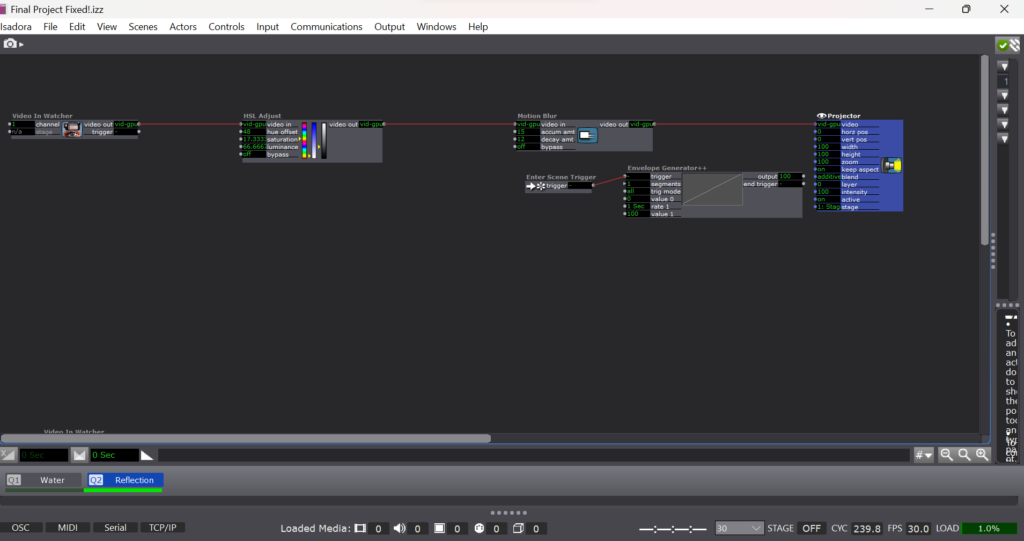
To imitate the instability of reflections in water I applied a motion blur to the reflection video. I also wanted to imitate the ghostliness of reflections in water, so I desaturated the image from the camera as well.

To emphasize the mysterious quality of my digital water, I used an additional motion sensor to deactivate the reflection scene. If the participant stops moving or moves out of the range of the camera, the reflection image fades away like the closing of a portal.
The patch itself is very simple. It’s two layers of projection and a simple motion detector. What matters to me is the way that this patch will eventually interact with the materials and how the materials with influence the way that the participant then engages with the patch.
For cycle 2, I will projection map the patch to the size of the pool, calibrating it for an uneven surface. I will determine what type of lighting I will need to support the web camera and appropriate placement of the web camera for a recognizable reflection. I will also need to recalibrate the comparater for a darker environment to keep the motion sensor functioning.
Cycle 3: Dancing with Cody Again – Mollie Wolf
Posted: December 15, 2022 Filed under: Uncategorized | Tags: dance, Interactive Media, Isadora, kinect, skeleton tracking Leave a comment »For Cycle 3, I did a second iteration of the digital ecosystem that uses an Xbox Kinect to manipulate footage of Cody dancing in the mountain forest.
Ideally, I want this part of the installation to feel like a more private experience, but I found out that the large scale of the image was important during Cycle 2, which presents a conflict, because that large of an image requires a large area of wall space. My next idea was to station this in a narrow area or hallway, and to use two projectors to have images on wither side or surrounding the person. Cycle 3 was my attempt at adding another clip of footage and another mode of tracking in order to make the digital ecosystem more immersive.
For this, I found some footage of Cody dancing far away, and thought it could be interesting to have the footage zoom in/out when people widen or narrow their arms. In my Isadora patch, this meant changing the settings on the OpenNI Tracker to track body and skeleton (which I hadn’t been asking the actor to do previously). Next, I added a Skeleton Decoder, and had it track the x position of the left and right hand. A Calculator actor then calculates the difference between these two numbers, and a Limit-Scale Value actor translates this number into a percentage of zoom on the Projector. See the images below to track these changes.
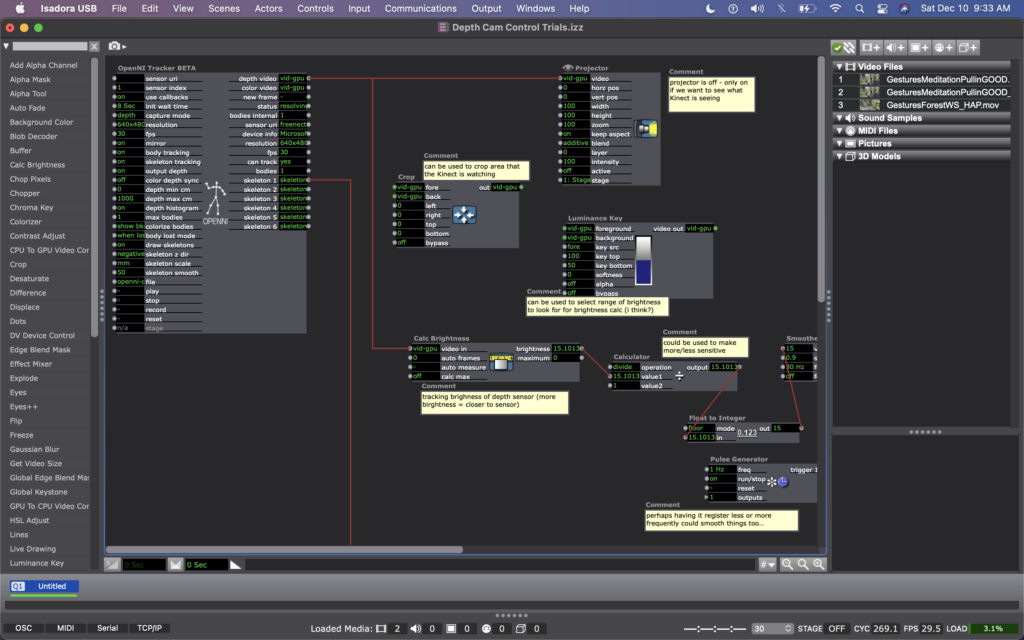
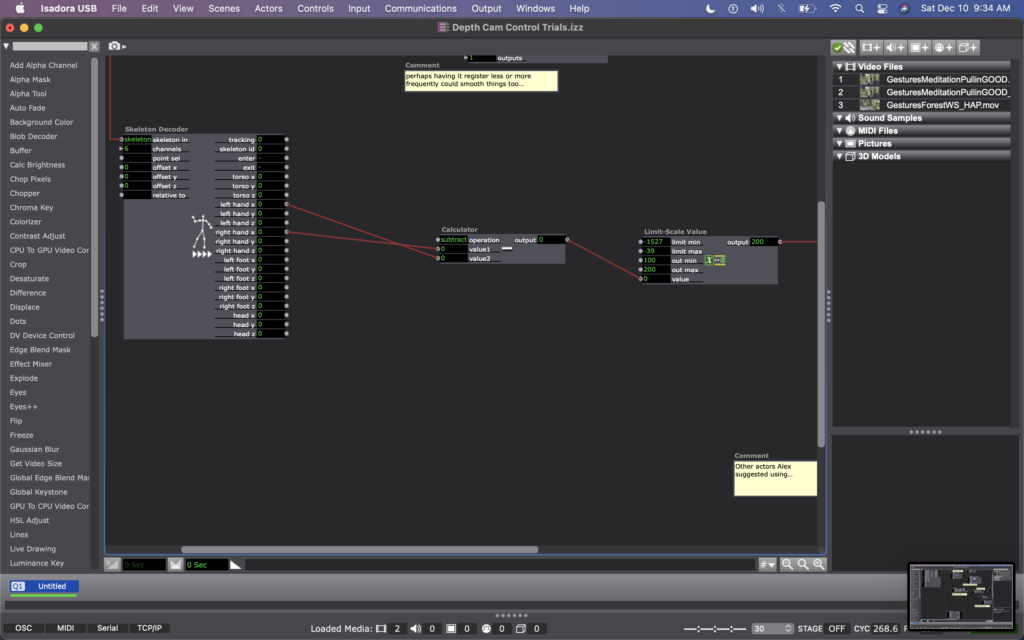
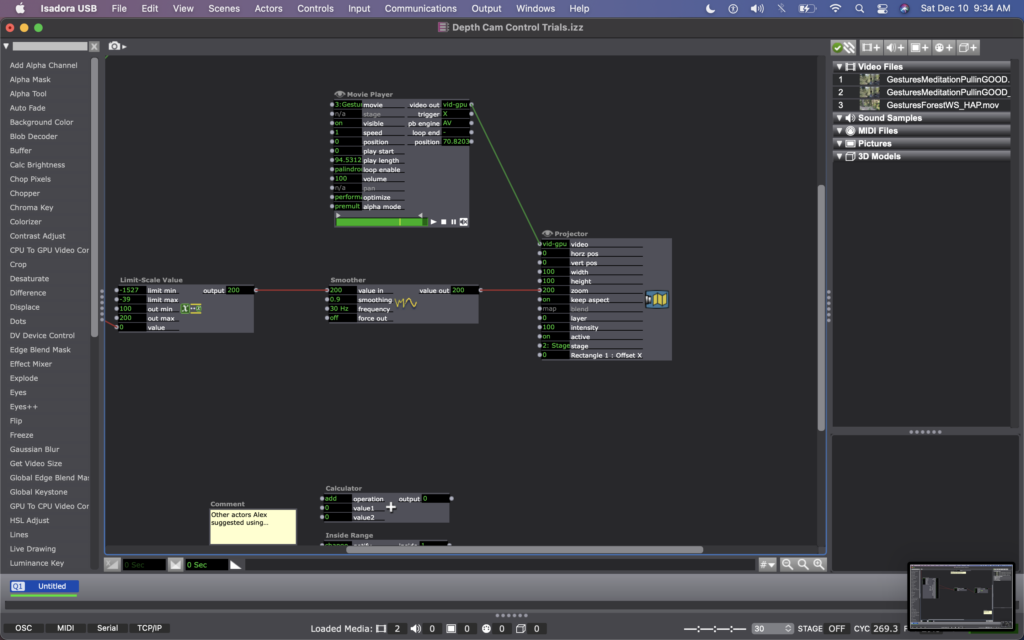
My sharing for Cycle 3 was the first time that I got to see the system in action, so I immediately had a lot of notes/thoughts for myself (in addition to the feedback from my peers). My first concern is that the skeleton tracking is finicky. It sometimes had a hard time identifying a body – sometimes trying to map a skeleton on other objects in space (the mobile projection screen, for example). And, periodically the system would glitch and stop tracking the skeleton altogether. This is a problem for me because while I don’t want the relationship between cause and effect to be obvious, I also want it to be consistent so that people can start to learn how they are affecting the system over time. If it glitches and doesn’t not always work, people will be less likely to stay interested. In discussing this with my class, Alex offered an idea that instead of using skeleton tracking, I could use the Eyes++ actor to track the outline of a moving blob (the person moving), and base the zoom on the width or area that the moving blob is taking up. This way, I could turn off skeleton tracking, which I think is part of why the system was glitching. I’m planning to try this when I install the system in Urban Arts Space.
Other thoughts that came up when the class was experimenting with the system were that people were less inclined to move their arms initially. This is interesting because during Cycle 2, people has the impulse to use their arms a lot, even though at the time the system was not tracking their arms. I don’t fully know why people didn’t this time. Perhaps because they were remembering that in Cycle 2 is was tracking depth only, so they automatically starting experimenting with depth rather than arm placement? Also, Katie mentioned that having two images made the experience more immersive, which made her slow down in her body. She said that she found herself in a calm state, wanting to sit down and take it in, rather than actively interact. This is an interesting point – that when you are engulfed/surrounded by something, you slow down and want to receive/experience it; whereas when there is only one focal point, you feel more of an impulse to interact. This is something for me to consider with this set up – is leaning toward more immersive experiences discouraging interactivity?
This question led me to challenge the idea that more interactivity is better…why can’t someone see this ecosystem, and follow their impulse to sit down and just be? Is that not considered interactivity? Is more physical movement the goal? Not necessarily. However, I would like people to notice that their embodied movement takes effect on their surroundings.
We discussed that the prompting or instructions that people are given could invite them to move, so that people try movement first rather than sitting first. I just need to think through the language that feels appropriate for the context of the larger installation.
Another notable observation from Tamryn was that the Astroturf was useful because it creates a sensory boundary of where you can move, without having to take your eyes off the images in front of you – you can feel when you’re foot reaches the edge of the turf and you naturally know to stop. At one point Katie said something like this: “I could tell that I’m here [behind Cody on the log] in this image, and over there [where Cody is, faraway in the image] at the same time.” This pleased me, because when Cody and I were filming this footage, we were talking about the echos in the space – sometimes I would accidentally step on a branch, causing s snapping noise, and seconds later I would hear the sound I made bouncing back from miles away, on there other side of the mountain valley. I ended up writing in my journal after our weekend of filming: “Am I here, or am I over there?” I loved the synchronicity of Katie’s observation here and it made my wonder if I wanted to include some poetry that I was working on for this film…
Please enjoy below, some of my peers interacting with the system.
Cycle 3–Allison Smith
Posted: April 28, 2022 Filed under: Uncategorized | Tags: dance, Interactive Media, Isadora 1 Comment »I had trouble determining what I wanted to do for my Cycle 3 project, as I was overwhelmed with the possibilities. Alex was helpful in guiding me to focus on one of my previous cycles and leaning into one of those elements. I chose to follow up with my Cycle 1 project that had live drawing involved through motion capture of the participant. This was a very glitchy system, though, so I decided to take a new approach.
In my previous approach of this, I utilized the skeleton decoder to track the numbers of the participants’ hands. These numbers were then fed into the live drawing actor. The biggest problem with that, though, is that the skeleton would not track well and the lines didn’t correspond to the person’s movement. In this new iteration, I chose to use a camera, eyes ++ and the blob decoder to track a light that the participant would be holding. I found this to be a much more robust approach, and while it wasn’t what I had originally envisioned in Cycle 1, I am very happy with the results.
I had some extra time and spontaneously decided to add another layer to this cycle, where the participant’s full body would be tracked with a colorful motion blur. With this, they would be drawing but we would also see the movement the body was creating. I felt like this addition leaned into my research in this class of how focusing on one type of interactive system can encourage people to move and dance. With the outline of the body, we were able to then see the movement and dancing that the participant’s probably weren’t aware they were doing. I then wanted to put the drawing on a see-through scrim so that the participant would be able to see both visuals being displayed.
A few surprises came when demonstrating this cycle with people. I instructed that viewers could walk through the space and observe however they wanted, however I didn’t consider how their bodies would also be tracked. This brought out an element of play from the “viewers” (aka the people not drawing with the light) that I found most exciting about this project. They would play with different ways their body was tracked and would get closer and farther from the tracker to play with depth. They also played with shadows when they were on the other side of the scrim. My original intention with setting the projections up the way that they were–on the floor in the middle of the room–was so that the projections wouldn’t mix onto the other scrims. I never considered how this would allow space for shadows to join in the play both in the drawing and in the bodily outlines. I’ve attached a video that illustrates all of the play that happened during the experience:
Something that I found interesting after watching the video was that people were hesitant to join in at first. They would walk around a bit, and they eventually saw their outlines in the screen. It took a few minutes, though, for people to want to draw and for people to start playing. After that shift happened, there is such a beautiful display of curiosity, innocence, discovery, and joy. Even I found myself discovering much more than I thought I could, and I’m the one who created this experience.
The coding behind this experience is fairly simple, but it took a long time for me to get here. I had one stage for the drawing and one stage for the body outlines. For the drawing, like I mentioned above, I used a video in watcher to feed into eyes ++ and the blob decoder. The camera I used was one of Alex’s camera as it had a manual exposer to it, which we found out was necessary to keep the “blob” from changing sizes when the light moved. The blob decoder finds bright points in the video, and depending on the settings of the decoder, it will only track one bright light. This then fed into a live drawing actor in its position and size, with a constant change in the colors.
For the body outline, I used an astra orbec tracker feeding into a luminance key and an alpha mask. The foreground and mask came from the body with no color, and the background was a colorful version of the body with a motion tracker. This created the effect of having a white colored silhouette with a colorful blur. I used the same technique for color in the motion blur as I did with the live drawing.



I’m really thankful for how this cycle turned out. I was able to find some answers to my research questions without intentionally thinking about that, and I was also able to discover a lot of new things within the experience and reflecting upon it. The biggest takeaway I have is that if I want to encourage people to move, it is beneficial to give everyone an active roll in exploration rather than having just one person by themselves. I was focused too much on the tool in my previous cycles (drawing, creating music) rather than the importance of community when it comes to losing movement inhibition and leaning into a sense of play. If I were to continue to work on this project, I might add a layer of sound to it using MIDI. I did enjoy the silence of this iteration, though, and am concerned that adding sound would be too much. Again, I am happy with the results of the cycle, and will allow this to influence my projects in the future.
Cycle 2–Allison Smith
Posted: April 7, 2022 Filed under: Uncategorized | Tags: Cycle 2, dance, Interactive Media, Isadora Leave a comment »For my cycles, I’m working on practicing different media tools that can interact with movement. For this cycle, I chose to work with the interaction of movement and sound. Similar to my PP2, I had a song with several tracks playing at the same time, and the volume would turn up when it’s triggered. The goal was to allow a space to play with movement and affect the sound, allowing that to affect the movement.
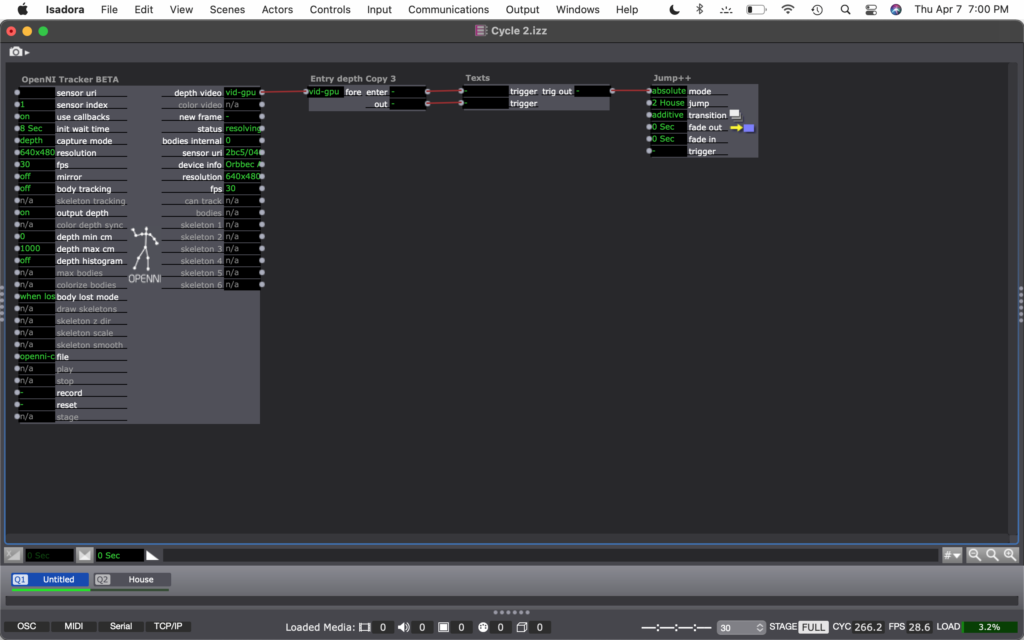
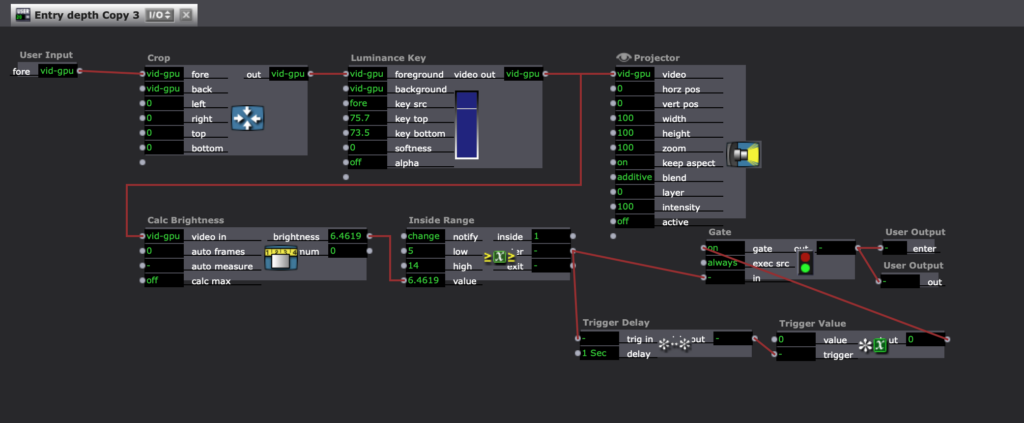



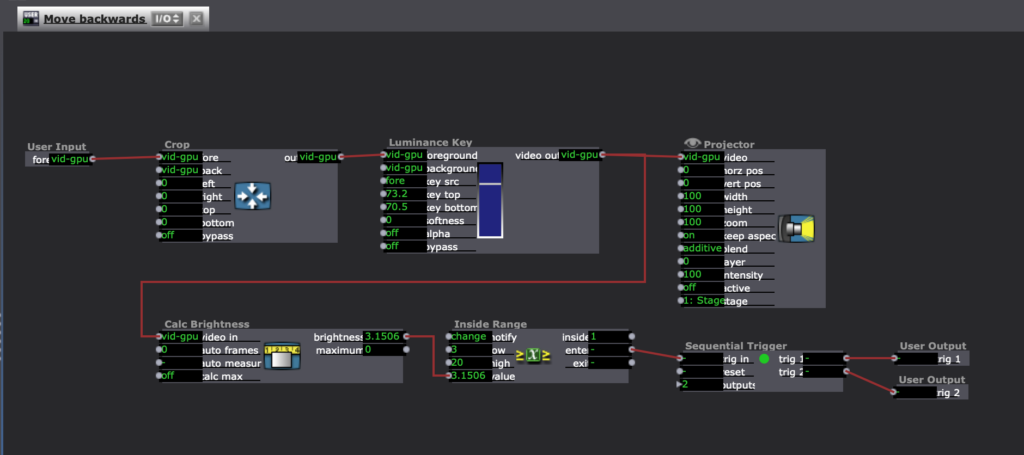
I had two possible audiences in mind for this. The first audience I was considering was people who don’t typically dance, and who find this in a type of installation and want to play with it. Like I mentioned at the beginning, I’m curious about how completing an activity motivated through exploration will knock down inhibitions that are associated with movement. Maybe finding out that the body can create different sounds will inspire people to keep playing. The other audience I had in mind was a dancer who is versed in freestyle dance, specifically in house dance. I created a house song within this project, and I inspired the movement triggers based on basic moves within house dance. Then, the dancer could not only freestyle with movement inspired by the music, but their movement can inspire the music, too.
For this demo, I chose to present it in the style for the first audience. Here is a video of the experience:
I ran into a few technical difficulties. The biggest challenge was how I had to reset the trigger values for each space I was in. The brightness of the depth was different in my apartment living room than it was in the MOLA. I also noticed that I was able to create the different boundaries based on my body and how I would move. No one moves exactly the same way, so sounds will be triggered differently for each person. It was also difficult to keep things consistent. Similarly to how each person moves differently from each other, we also don’t ever move exactly the same. So when a sound is triggered one time, it may not be triggered again by the same movement. Finally, there was a strange problem where the sounds would stop looping after a minute or so, and I don’t know why.
My goal for this cycle was to have multiple songs to play with that could be switched between in different scenes. If I were to continue to develop this project, I would want to add those songs. Due to time constraints, I was unable to do that for this cycle. I would also like to make this tech more robust. I’m not sure how I would do that, but the consistency would be nice to establish. I am not sure if I will continue this for my next cycle, but these ideas are helpful to consider for any project.
Cycle 3! – Thank a Black Woman
Posted: December 12, 2019 Filed under: Kylee Smith | Tags: Black women, dance, family, hair, installation, intermedia, spirit, thank you Leave a comment »The last round of this project was very fulfilling. I was so happy to be able to share my work with some new faces and for it to continue to be received so well by my classmates. The feedback that I got afterwards was incredibly affirming–it was a valuable and meaningful experience for my participants. Everything didn’t go perfect (I forgot to press record the first time around, whoops lol), but I decided to just go with it, and not be frantic about it. I would love another opportunity to dig the work just a little bit more because I feel that there is still more there to excavate.
This class, and this project in particular, has been inspiring in my personal research practice, and I am looking for ways to deepen these kinds of intermedia installation explorations and how they might inform the way I am crafting my MFA thesis.
I am extremely grateful for this experience. Thank you Oded and Alex for being tremendous supporters of a work that wasn’t about you. That doesn’t happen often.
Go tell a Black woman thank you. We deserve to be celebrated.
I will leave you with some images from my last exhibition.
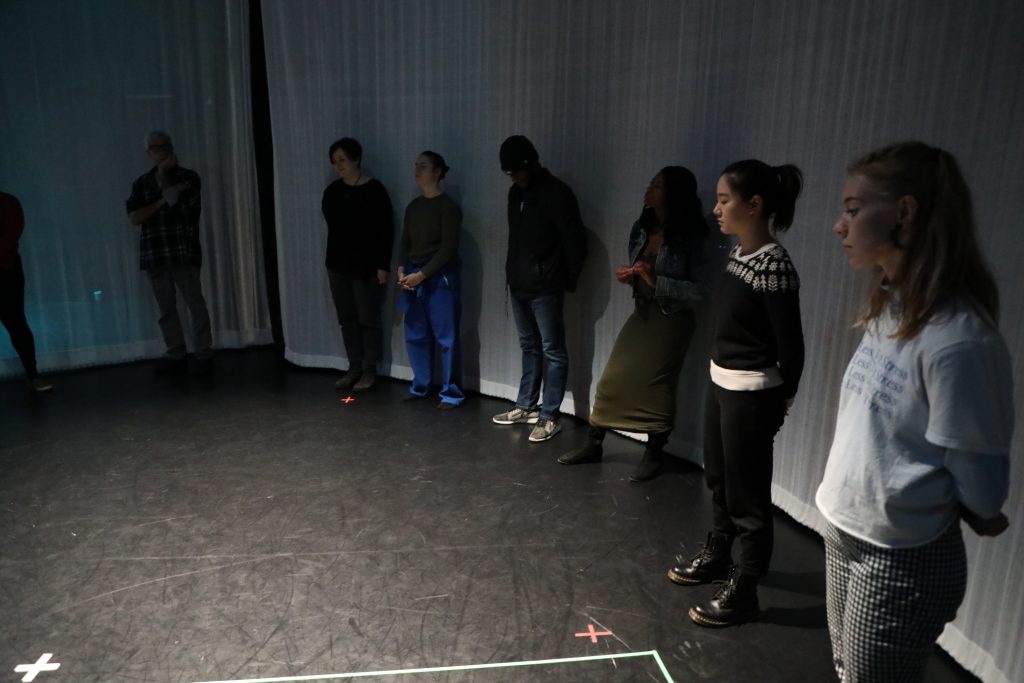
The participants listen back to the thank you’s 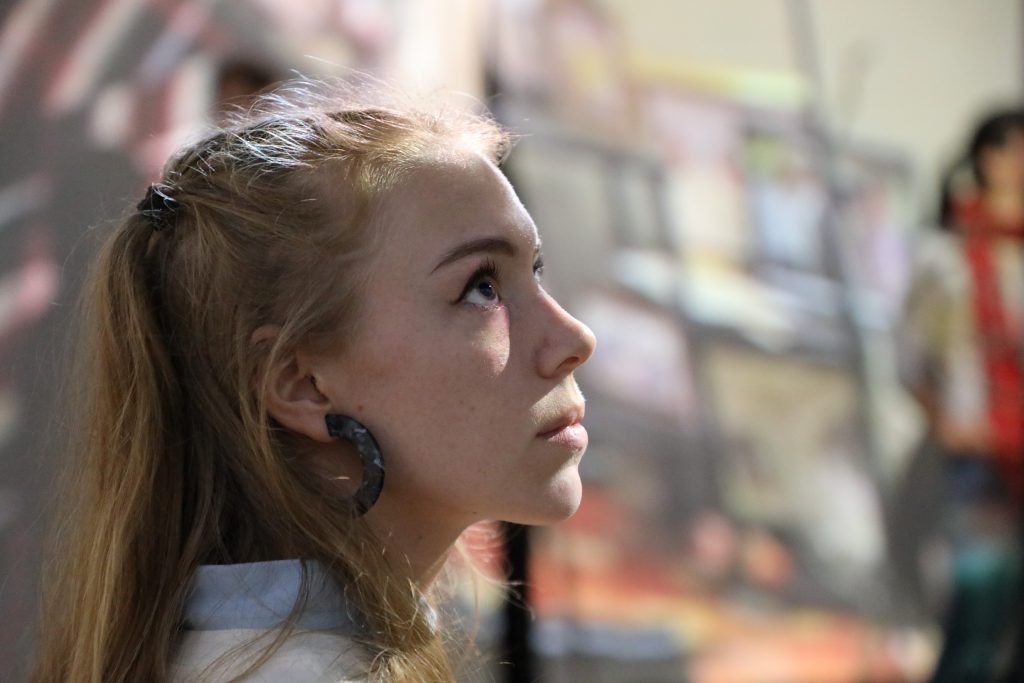
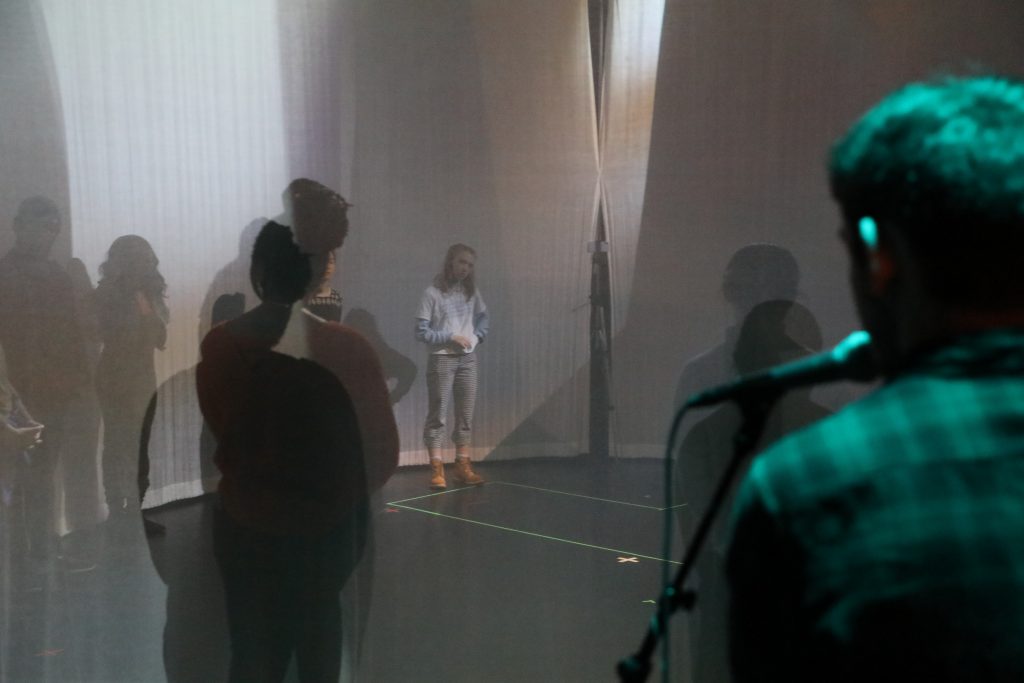
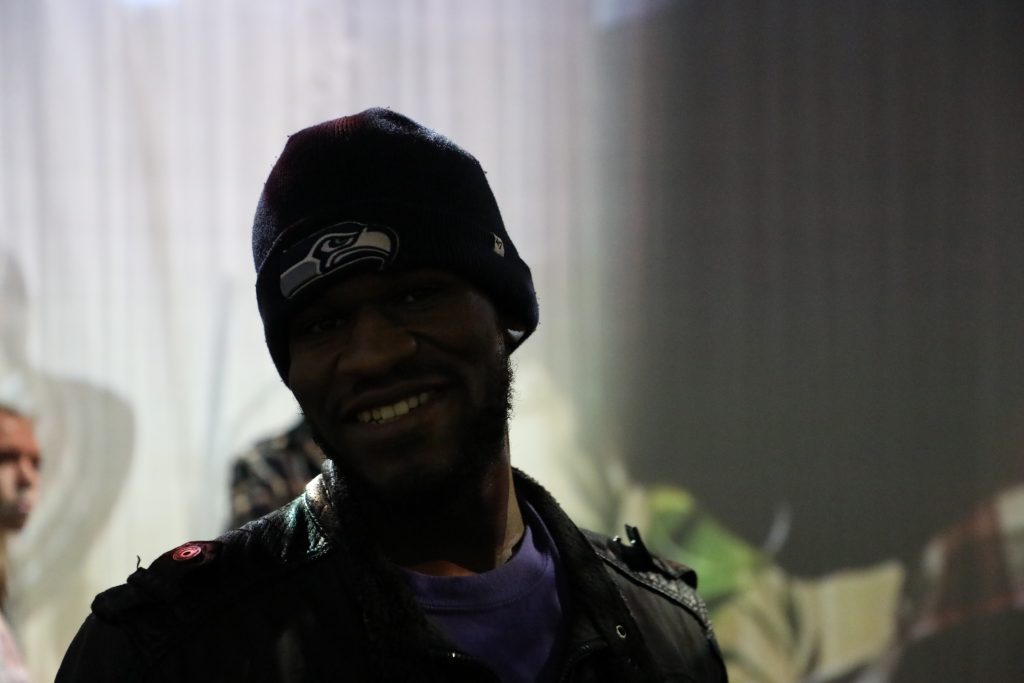

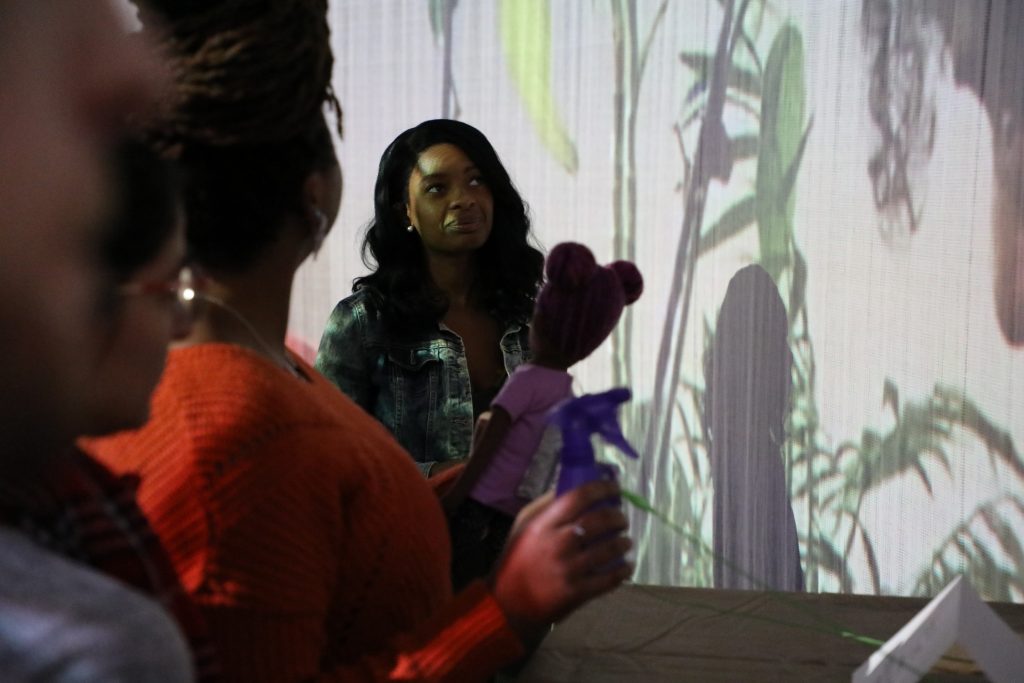
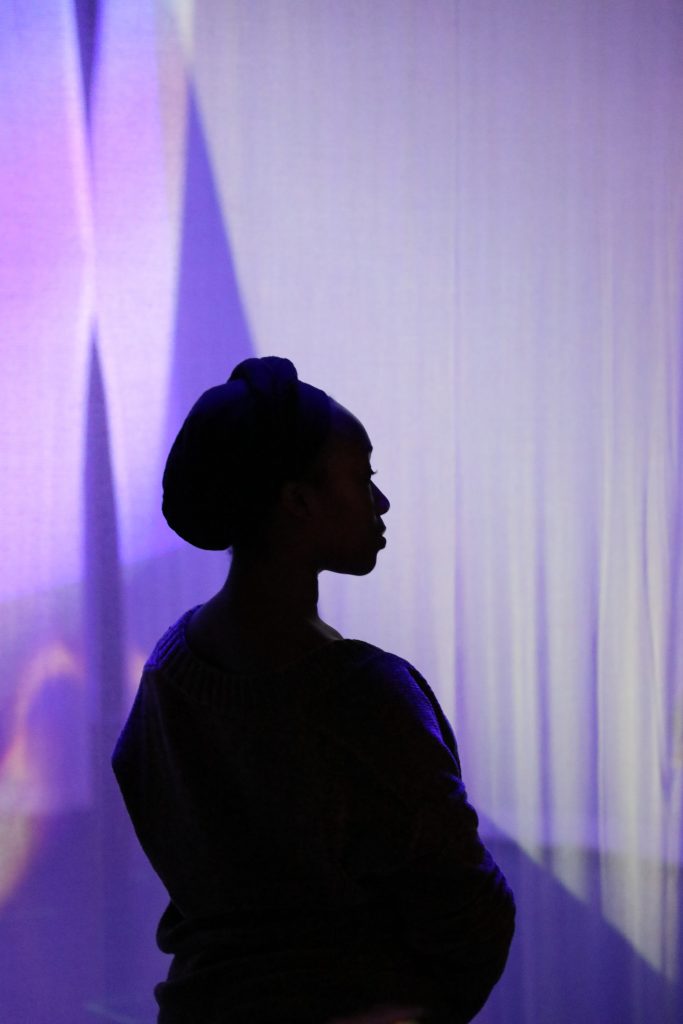
The Black woman behind it all, me — Kylee C. Smith
Final Mission: three travelers
Posted: December 11, 2019 Filed under: Emily Craver, Final Project | Tags: choose your own adventure, dance, Isadora Leave a comment »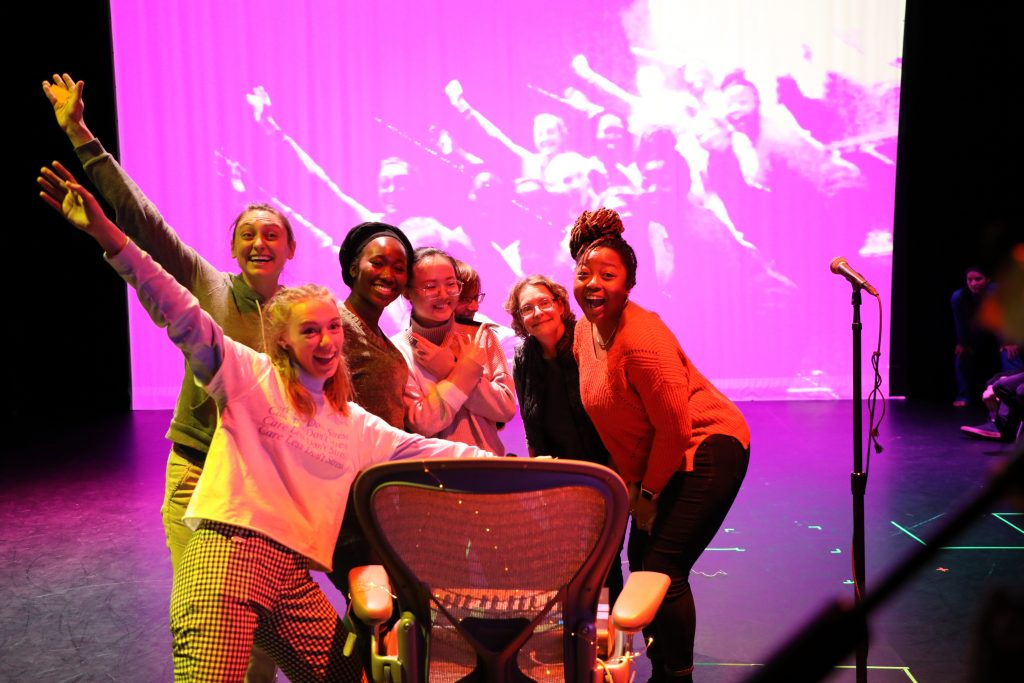
photo by Alex Oliszewski
During my Cycle 3 of Choose Your Own Adventure: Live Performance Edition, I explored how to allow for more timelines. I realized that the moments of failure for the audience provides excitement and raises the stakes of the performance. How to make a system that encourages and provides feedback for the volunteers while also challenging them?
I feel most creative and myself when creating pieces that play with stakes. I love dance and theatre that encourages heightened reactions to ridiculous situations. The roles of the three travelers started to sink in to me the more we rehearsed. They needed to be both helpless adventurers somewhere distant in time and space while also being all-knowing, somewhat questionably trustworthy narrator-like greek chorus assistants. Tara, Yildiz and I added cheering on the volunteers to blur those lines of where and who we are.
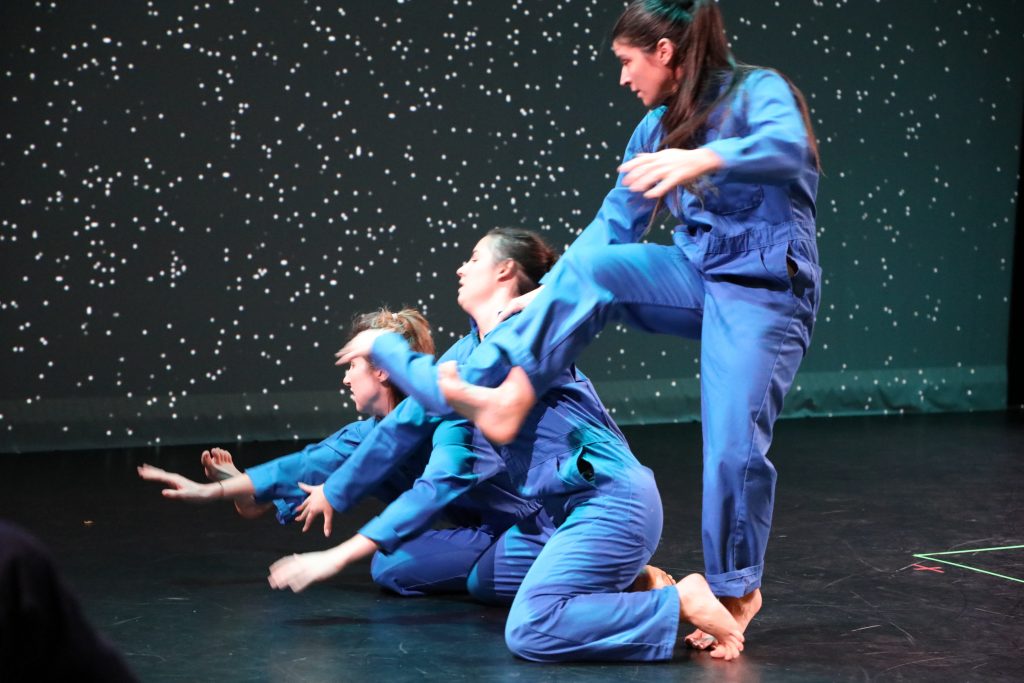
photo by Alex Oliszewski
The new system for Choose Your Own Adventure included: MIDI keyboard as a controller, Live Webcam for a live feed of adventurers and photo capture of successes, FocusRite Audio hook-up for sound input and sound level watcher, GLSL shaders of all colors and shapes, and Send MIDI show control in order to trigger light cues.
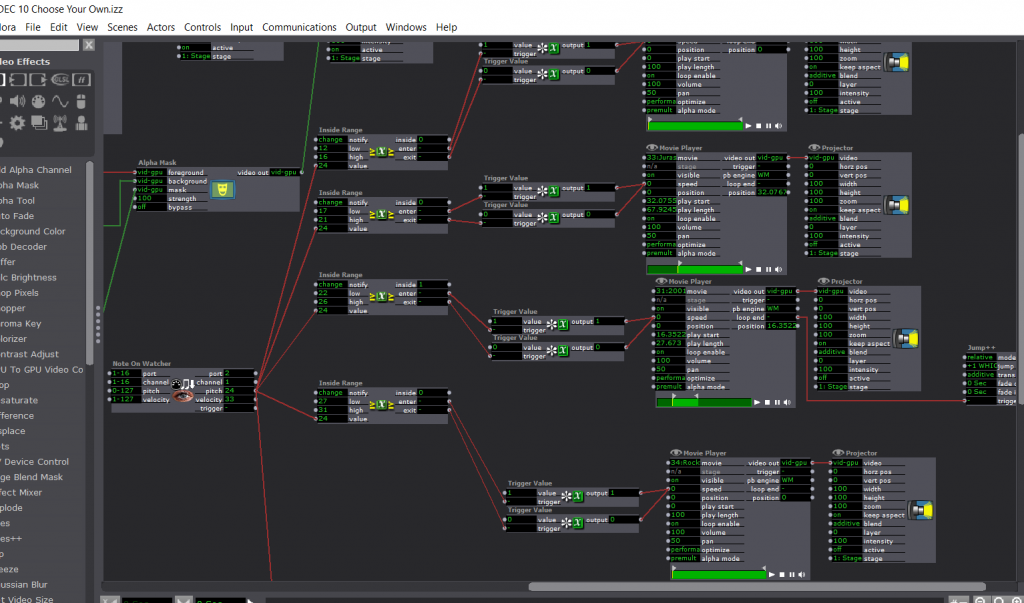
The new system provided more direct signs of sound level watching and cues to the volunteers. The voice overs were louder and aided by flashing text reiterating what the audience should be doing. The three travelers became side coaches for the volunteers as well as self-aware performers trying to gain trust. I found myself fully comfortable with the way the volunteers were being taken care of and started to question and wonder about the audience who was observing all of this. How can an audience be let in while others are physically engaging with the material? I thought about perhaps close camera work of the decisions being made at the keyboard? Earlier suggestions (shout out to Alex Christmas who gave this suggestion) included an applause-o-meter to allow for the non-volunteers to have a say from their seats. A “Who Wants to be a Millionaire” style audience interaction comes to mind with options for volunteers to choose how to interact and have the audience come to their aid. What does giving audience a voice look like? How can it be both respectful, careful and challenging?

